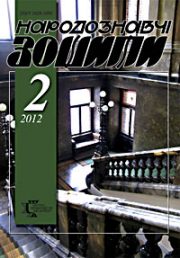The Ethnology Notebooks. 2024. № 2 (182), 423—438
UDK 393; 393.05; 394.2; 394.5; 398.332
DOI https://doi.org/10.15407/nz2025.02.423
SYMBOLIC FUNERAL IN UKRAINIAN PROTEST FOLKLORE: A TRANSFORMED TRADITION
IVANNIKOVA Lіudmyla
- ORCID ID: https://orcid.org/0000-0003-0617-5082
- Dr. Philology, Senior Scientific Worker,
- Rylsky Institute for Art Studies, Folklore and Ethnology,
- Ukrainian National Academy of Sciences,
- 4, Hrushevskoho str., 01001, Kyiv, Ukraine,
- Contacts: e-mail: ivannikovafolk@ukr.net
Abstract. The subject of this study is the symbolic funeral, which has been little studied by folklorists. It arose in the 20th century as a form of protest against totalitarian regimes. In recent decades, it has become an regular part of street actionism and one of the components of mass culture in Ukraine. Scientific novelty: this is the first work in the history of Ukrainian folklore devoted to this topic.
The purpose of the study is to trace the process of transformation of the traditional ritual from archaic to modern profane forms, the change in its semantics and pragmatics, subject, verbal and action codes, to clarify the pragmatics of modern forms of symbolic funeral in the context of Ukrainian protest folklore, its connection with memorial practices of the 20th—21st centuries, with imitative magic, and interaction with other forms of protest folklore. The source base of the article is the author’s own observations, materials collected over several decades, and publications on social networks.
In traditional culture, along with the sacred funeral ritual, there is a whole range of its profane forms, which are called metaphorical or symbolic funerals. They imitate a real funeral in a symbolic form. They are spread mainly as elements of calendar rites. Their goal is to send into oblivion a certain being, and at the same time the phenomenon of nature that it symbolizes. In addition to symbolic ones, there were various game and parody forms of funeral in folk culture. These are games at the dead, children’s games at the funeral or at the dead. Their pragmatics consisted in the assimilation of traditional norms of behavior through the game. They also had a protective and entertaining function. They were accompanied by pretended crying, parodied the main elements of the rite. Thus, the funeral gradually moved from the sphere of the sacred to the sphere of the profane and became an ordinary part of the culture of laughter.
On the basis of sacred and profane forms, another occasional form of symbolic funeral emerged. It dominates mainly in urban culture. It has become one of the most popular types of performance, in which a large number of protesters usually participate. This is a symbolic funeral of certain political and social phenomena (state system, worldview system, party ideology, economic formation) and odious personalities. This is a kind of protest against various totalitarian, occupation and criminal regimes in Ukraine and their leaders.
Keywords: folklore of protests and revolutions, symbolic funeral, performance, coffin, tombstone, imitative magic, modern magical practices.
Received 11.03.2025
REFERENCES
- Koval-Fuchylo, I. (2014). Ukrainian laments: anthropology of tradition, poetics of text. Kyiv: IMFE of the National Academy of Sciences [in Ukrainian].
- Ivannikova, L., Koval-Fuchylo, I., & Shalak, O. (2004). «Dziady» and «Mermaids’ Farewell» in the village of Gavronshchyna, Makariv district, Kyiv region. Dialectological studies. Schools, figures, problems (Pp. 503—519). Lviv [in Ukrainian].
- Konobrodska, V. (2007). Polissya funeral and memorial rites. Ethnolinguistic studies (Vol. 1). Zhytomyr: Polissja [in Ukrainian].
- Kurochkin, O. (2014). The Festive Year of Ukrainians (from Antiquity to the Present). Bila Tserkva: Publisher Oleksandr Pshonkivskyi [in Ukrainian].
- Kuzelia, Z. (1915). Sitting and entertainment near the dead in the Ukrainian funeral rite. Submitted by Zenon Kuzelya (Konec). Notes of the Shevchenko Scientific Society (Vol. CXXII, pp. 103—166). Lviv [in Ukrainian].
- Kyrpa, H. (2017). The Thirteenth Month of the Year. A Story. Lviv: Old Lion Publishing House [in Ukrainian].
- Funny funeral. Retrieved from: https://www.svoboda.org/a/24267275.html (access date: 04.03.2025) [in Ukrainian].
- Guziy, R. (2007). From folk thanatology: Carpathian traces. Lviv: Institute of Ethnology NAS of Ukraine [in Ukrainian].
- Chebanyuk, O. (2005). «Orange Revolution» in the folklore of Kyiv Maidans and streets. The young nation. Special issue: Orange Revolution, 1, 177—191 [in Ukrainian].
- Yefremov, S. (1997). Diaries. 1923—1929. Kyiv: «Gazeta RADA» [in Ukrainian].
- Gonchar, O., & Gonchar, V. (Ed.). (2004). Diaries: in 3 vol. (Vol. 3). Kyiv: Veselka [in Ukrainian].
- The «Funeral» of Communism in Lviv. Retrieved from: https://www.volynpost.com/news/22479-pohoron-komunizmu-v-lvovi-foto (access date: 04.03.2025) [in Ukrainian].
- In Kyiv, Lviv residents are driving nails into the coffin of communism. Retrieved from: https://portal.lviv.ua/news/2014/08/14/093101 (access date: 04.03.2025) [in Ukrainian].
- In Odessa, they held a funeral for Putin and burned his coffin near the Russian consulate. Retrieved from: https://www.youtube.com/watch?v=kYn5gB_m8Wc (access date: 04.03.2025) [in Ukrainian].
- Putin in a coffin was brought to the Russian consulate in Kharkov. Retrieved from: https://ukranews.com/news/449671-putyna-v-grobu-prynesly-pod-konsulstvo-rf-v-kharkove (access date: 04.03.2025) [in Ukrainian].
- The coffin with «Putin» was carried through the center of Kharkov. Retrieved from: https://www.youtube.com/watch?v=tkmiT8ZNc88 (access date: 04.03.2025) [in Ukrainian].
- 17. Lviv residents «buried» a Russian bank. Retrieved from: https://wz.lviv.ua/news/158455-lviviany-pokhovaly-rosiiskyi-bank (access date: 24.07.2022) [in Ukrainian].
- Russian business «buried» in Lviv. Retrieved from: https://day.kyiv.ua/uk/photo/u-lvovi-pohoronyly-rosiyskyy-biznes; https://dailylviv.com/news/polityka/u-lvovi-pokhovaly-viddilennya-alfa-banku-video-27847 (access date: 24.07.2022) [in Ukrainian].
- A coffin with a pig’s corpse and wreaths was brought to the Rada. Retrieved from: https://www.pravda.com.ua/news/2019/11/13/7231819/ (access date: 04.03.2025) [in Ukrainian].
- In Mariupol, a funeral home presented the «DPR» with a coffin with the inscription «Get out of the city!» Retrieved from: https://www.unian.ua/society/925924-u-mariupoli-pohoronne-byuro-podaruvalo-dnr-trunu-z-napisom-get-z-mista-foto.html (access date: 04.03.2025) [in Ukrainian].
- In Cherkasy, funeral homes advertise with tombstones of Yanukovych and Azarov. Retrieved from: https://life.pravda.com.ua/society/2014/04/16/163948/ (access date: 04.03.2025) [in Ukrainian].
- In Cherkasy region, gravestones were made for Symonenko, Tsariov, and Pshonka. Retrieved from: https://tsn.ua/tsikavinki/na-cherkaschini-vigotovili-mogilni-pliti-dlya-simonenka-carova-ta-pshonki-348278.html (access date: 04.03.2025) [in Ukrainian].
- A grave monument to Vladimir Putin was erected in Zaporizhia. Retrieved from: http://1news.zp.ua/u-zaporizhzhi-vstanovili-mogilnij-pamyatnik-volodimiru-putinu-foto/ (access date: 04.03.2025) [in Ukrainian].
- The residents of Ladyzhyn erected a tombstone for Putin over the «grave». Retrieved from: https://misto.vn.ua/vijna/meshkanci-ladizhina-vstanovili-putinu-nadgrobok-nad-mogiloyu/ (access date: 04.03.2025) [in Ukrainian].
- The holiday is coming. Retrieved from: https://www.google.com/search?client=firefox-b-d&q=%D0%A1%D0%B2%D1%8F%D1%82%D0%BE+%D0%BD%D0%B0%D0%B1%D0%BB%D0%B8%D0%B6%D0%B0%D1%94%D1%82%D1%8C%D1%81%D1%8F (access date: 04.03.2025) [in Ukrainian].






